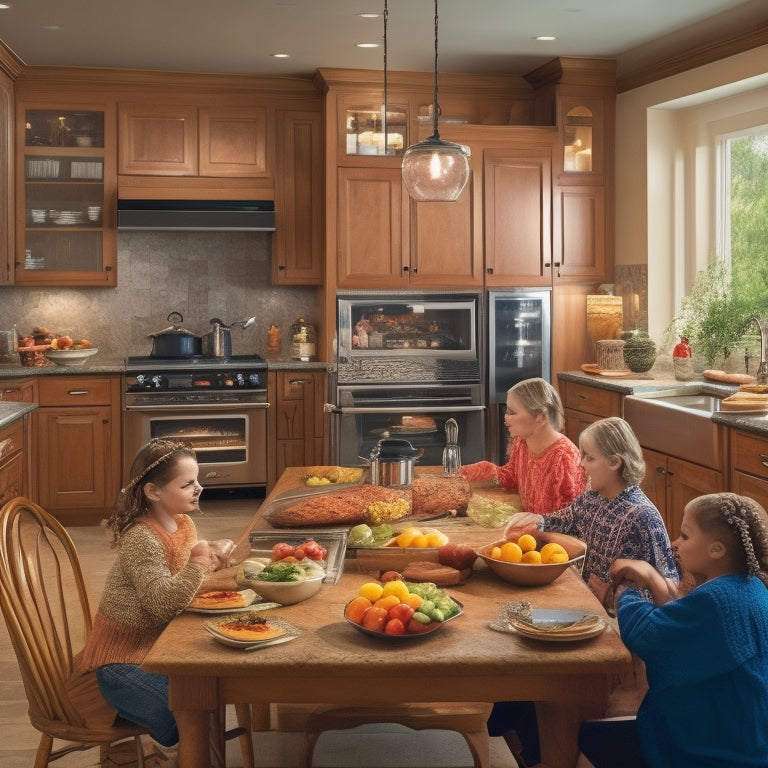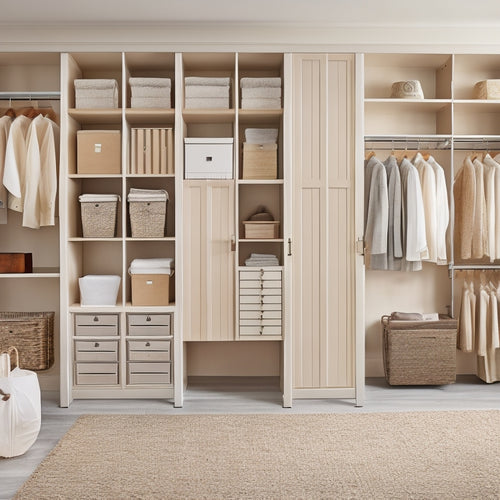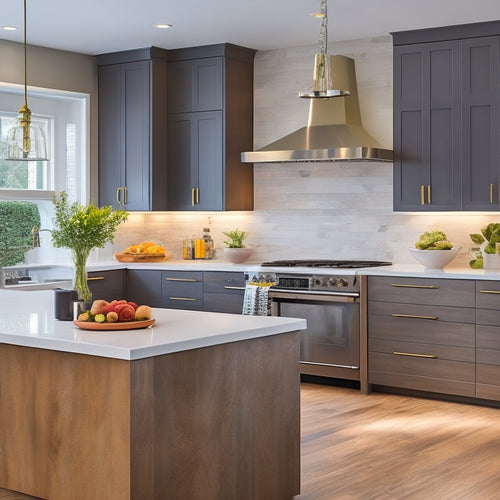
7 Essential Kitchen Systems for Large Families
Share
When managing a large family, you need a kitchen that's optimized for efficiency, functionality, and space. To achieve this, focus on seven essential systems: maximizing counter space with multi-functional appliances and smart storage, streamlining meal prep with a dedicated station, optimizing pantry storage with labeled containers, implementing a smart refrigerator organization system, utilizing effective cabinet strategies, designing a centralized cooking zone, and incorporating functional island workstations. By mastering these systems, you'll reveal a more efficient, stress-reducing kitchen that keeps up with your family's demands. Now, explore how to tailor these systems to your family's unique needs.
Key Takeaways
- Maximize kitchen space and organization by utilizing multi-functional appliances, smart storage solutions, and assigning homes for items.
- Implement a streamlined meal preparation system with a designated prep station, essential tools, and meal planning strategies to reduce stress.
- Designate a centralized cooking zone with adequate counter space, storage solutions, and efficient layout to enhance workflow and minimize interruptions.
- Incorporate functional kitchen features such as a functional island workstation, task-oriented lighting, and multi-functional design to support various family activities.
- Maintain organization and efficiency by regularly assessing pantry contents, labeling containers, and implementing clutter reduction strategies.
Maximizing Counter Space Efficiency
When it comes to cooking for a large family, maximizing counter space efficiency is essential. You need to make the most of the available space to accommodate multiple dishes, ingredients, and cooking tasks simultaneously.
To achieve this, consider the placement and selection of countertop appliances. Choose multi-functional appliances that serve more than one purpose, such as a toaster oven with a cooktop, to reduce clutter and free up space.
Implement clutter reduction strategies like assigning a home for each item, using vertical storage, and labeling containers to maintain organization. By leveraging smart storage solutions, you can optimize your counter space even further.
Additionally, consider integrating digital tools that automate routine tasks, enhancing cooking and meal prep efficiency.
Streamlined Meal Prep Station
Beyond the countertop, a streamlined meal prep station is crucial for efficient cooking. You need a dedicated area where you can plan, prepare, and execute meals without feeling overwhelmed.
Start by designating a specific zone for meal planning, where you can keep your recipe books, meal planning calendars, and shopping lists within easy reach.
Next, invest in essential prep tools like a large cutting board, a knife block, and a utensil organizer. These will help you stay organized and focused as you chop, dice, and sauté your way through meal prep.
With a streamlined meal prep station, you'll be able to cook healthy, delicious meals for your large family without sacrificing precious time or energy.
Optimized Pantry Storage Solutions
A well-stocked pantry is the backbone of a kitchen system for large families, and optimized pantry storage solutions are vital to keeping it running smoothly.
You need a system that allows you to easily access and manage your pantry inventory. Consider installing shelves, baskets, and bins that cater to your family's specific needs. Label each container to guarantee everyone knows what's inside.
Implement seasonal storage by dedicating areas for items used only during specific times of the year, such as holiday baking supplies or summer snacks. This will help reduce clutter and make meal planning more efficient.
Smart Refrigerator Organization System
You'll want to create a smart refrigerator organization system that maximizes storage and reduces food waste.
To do this, you'll need to assign zones within the fridge for specific food groups, label contents for easy visibility, and prioritize frequently used items for convenient access.
Zone Assignments Matter
About five family members relying on one refrigerator can lead to chaos, especially when everyone has different eating habits and schedules.
To maintain order, you need to establish zone assignments within your refrigerator. This means designating specific areas for specific family members or food categories. For instance, you can allocate a shelf for each child's snacks or a section for leftovers.
By doing so, you're streamlining your kitchen workflow and respecting individual preferences. This system also helps to reduce clutter and promotes accountability within your family relationships.
Labeling for Visibility
By the time you've assigned zones within your refrigerator, it's vital to take the next step: labeling for visibility. This guarantees that everyone in your large family can quickly identify what's inside the fridge.
Effective labeling involves using color coding, clear fonts, and durable materials that can withstand the humid fridge environment.
- Place labels at eye level to facilitate easy reading and use magnetic labels for flexibility in label placement.
- Implement category themes, such as "dairy" or "snacks," and use child-friendly labels to encourage independence.
- Consider using seasonal labels to keep track of seasonal items and multi-purpose labeling to minimize clutter in your kitchen inventory.
Prioritize Frequently Used
How often do you find yourself digging through the fridge to locate your favorite snacks or beverages? A smart refrigerator organization system should prioritize frequently used items to save you time and effort.
Start by categorizing your fridge contents into zones based on meal planning and ingredient accessibility. Designate a "quick-grab" zone for frequently consumed items like milk, eggs, and juice.
Store less frequently used items, like special occasion foods or leftovers, in harder-to-reach areas. By prioritizing frequently used items, you'll reduce clutter and make meal prep more efficient.
This system also encourages mindful meal planning, as you'll be more aware of your inventory and can plan meals around what you already have on hand.
Effective Cabinet Utilization Strategies
You'll get the most out of your kitchen cabinets by employing a few strategic techniques.
First, you'll want to maximize your vertical storage by using stackable shelves and baskets to make the most of the space from floor to ceiling.
Maximize Vertical Storage
The challenge of outfitting a kitchen for a large family often lies in creating sufficient storage without sacrificing precious floor space.
You need to think vertically to maximize your kitchen's potential. By doing so, you'll create more room for food, cookware, and utensils without cluttering your countertops or floor.
Consider the following strategies to maximize your kitchen's vertical storage:
- Install hanging racks for pots, pans, and utensils, keeping them organized and within reach.
- Use stackable containers to store dry goods, such as pasta, rice, and snacks, on high shelves.
- Take advantage of the space above your cabinets by installing overhead storage units for infrequently used items, like special occasion dishes or cookbooks.
Optimize Corner Cabinets
As corner cabinets often prove to be the most challenging spaces to employ effectively, it is essential to implement clever storage solutions to make the most of these areas. To optimize corner cabinet organization, consider the following hidden storage solutions:
| Solution | Description |
|---|---|
| Lazy Susan | A rotating shelf that allows easy access to items in the back of the cabinet |
| Carousel | A multi-tiered storage system that maximizes vertical space |
| Pull-out Baskets | Baskets that slide out of the cabinet for easy access to contents |
| Adjustable Shelves | Shelves that can be customized to fit different sizes of items |
Label and Categorize
Having maximized your corner cabinet's storage potential, it's time to focus on effective cabinet utilization strategies. You've got the space, now it's time to optimize it.
Labeling and categorizing your cabinets will help you maintain organization and guarantee that everything has its designated place. This is especially important for large families, where meal planning and grocery organization can be overwhelming.
- Assign categories to each cabinet, such as baking supplies, cooking utensils, or food storage.
- Use labels and signs to identify what's inside each cabinet, making it easy for family members to find what they need.
- Designate a specific cabinet for kitchen gadgets and appliances, keeping them organized and out of the way.
Centralized Cooking Zone Design
Designate a dedicated space for meal prep and cooking to create a centralized cooking zone.
This zone should be strategically located in your kitchen layout to optimize cooking flow. You'll want to position it near essential appliances, such as the stove, oven, and refrigerator, to minimize walking distances and maximize efficiency.
Consider a U-shaped or L-shaped layout to create a functional workspace. Guarantee ample counter space and storage for utensils, pots, and pans within easy reach.
A well-designed centralized cooking zone will streamline meal prep, reduce chaos, and make cooking for your large family a breeze.
Functional Island Workstation Essentials
With a centralized cooking zone in place, you can now focus on creating a functional island workstation that complements your kitchen's workflow.
This multifunctional hub should include essential features that cater to your family's needs.
- Island seating for casual meals and homework sessions
- A prep sink and integrated appliances for efficient food preparation
- A charging station with power outlets, decorative storage for cooking tools, and a built-in herb garden for fresh ingredients, all under task-oriented lighting solutions that facilitate family communication and collaboration
Frequently Asked Questions
How Can I Prevent Clutter From Building up Over Time?
You can prevent clutter from building up by implementing decluttering strategies, like the "one in, one out" rule, and establishing daily routines, such as dedicating 10 minutes each day to tidying up, to maintain a clutter-free space that stays organized over time.
Are Custom Kitchen Systems Worth the Investment for Large Families?
Imagine your kitchen as a well-oiled machine, humming along smoothly. You're the conductor, orchestrating meal prep with ease. Investing in custom storage solutions designed for your family's needs will harmonize your kitchen, making family meal planning a breeze, and justifying the investment.
Can I Implement These Systems in a Rental Property?
You can implement space-optimizing systems in a rental property, but be prepared to negotiate with your landlord about rental modifications and potential damages or reversions when you move out.
How Do I Involve My Family Members in Kitchen Organization?
You'll find that assigning family roles and creating organization games sparks motivation; research shows that involving family members in decision-making increases their sense of ownership and responsibility, making kitchen organization a team effort.
Are There Any DIY Alternatives to Hiring a Professional Organizer?
You can create budget-friendly solutions by repurposing items like crates, baskets, and shelves to maximize storage. Get creative with DIY projects, like upcycling old furniture or building your own storage units, to achieve organized kitchen spaces without hiring a pro.
Related Posts
-

10 Essential Online Closet Organization Tips for Beginners
You're about to organize your closet like a pro! Start by setting up a virtual closet using an app or spreadsheet to ...
-

What Makes a Closet Organization System Efficient?
You achieve an efficient closet organization system by understanding your space, purging clutter, and categorizing be...
-

Smart U-Shaped Kitchen Remodeling Solutions
You're undertaking a smart U-shaped kitchen remodeling project, and optimizing space efficiency is key to creating a ...


